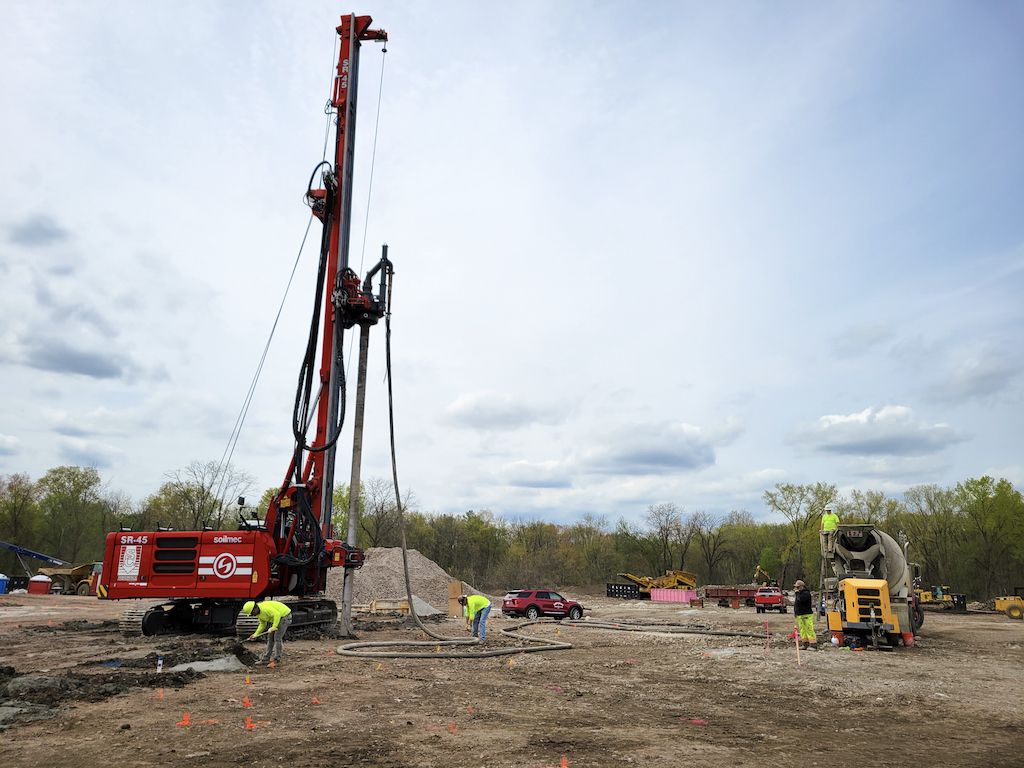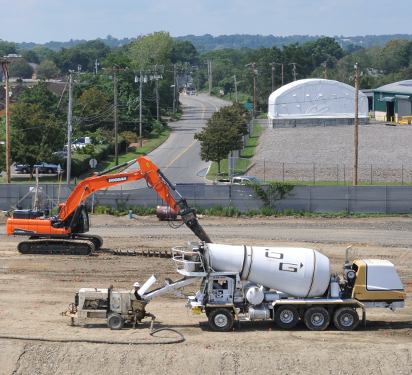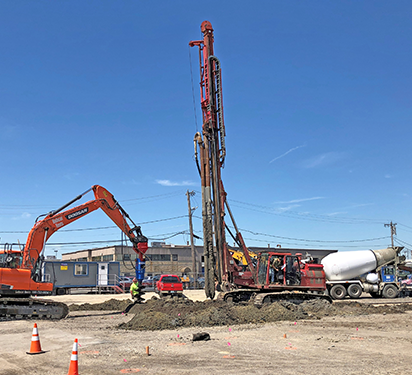Rigid Inclusions / Vibro Concrete Columns
Rigid inclusions are unreinforced, grouted or concrete columns installed in very soft soils to meet settlement criteria and improve bearing capacity for support of shallow foundations of a structure.
The phrase rigid inclusion may also be used to describe a vibro concrete column (VCCs) or fully grouted column. Vibro concrete columns are a type of rigid inclusion, which is an unreinforced, grouted or concrete column installed in very soft soils.
The soils on some sites are too soft for ground improvement with vibro stone columns and rammed piers. On these projects, vibro concrete columns may be the most feasible and cost-effective technique to mitigate the soft soils, meet settlement criteria and improve bearing capacity for the structure.

Subsurface Constructors installs 2,500 rigid inclusions for a residential apartment complex.
When to Use Rigid Inclusions / Vibro Concrete Columns
Rigid inclusions are considered ground improvement because they are not structurally connected to what they are supporting, such as building footings. Rigid inclusion is a broad term used to encapsulate the different displacement installation methods for these grouted columns. At Subsurface Constructors, we use vibratory probes to install concrete columns, making our rigid inclusions categorized as vibro concrete columns, or VCCs.
 This method of ground improvement is used for very weak soils, such as organic silt, peat, very soft clay or any soil lacking the strength to provide lateral support for stone columns / aggregate piers construction. VCCs improve bearing capacity and allow the structure to meet settlement criteria. The technique is used to provide support on the following types of structures:
This method of ground improvement is used for very weak soils, such as organic silt, peat, very soft clay or any soil lacking the strength to provide lateral support for stone columns / aggregate piers construction. VCCs improve bearing capacity and allow the structure to meet settlement criteria. The technique is used to provide support on the following types of structures:
- Buildings
- Large tanks
- Earthen embankments
- Bridge approaches with mechanically stabilized earth walls
Rigid Inclusions / Vibro Concrete Columns Design & Installation
Our engineers design rigid inclusions by first analyzing the soil properties as described in the geotechnical soil report as well as information on the structure’s loading conditions. It is preferable to have cone penetrometer testing (CPT) information of the soft soils to best characterize their settlement characteristics.

Rigid inclusions / VCCs typically range in diameter from 18 to 24 inches and can be installed at depths of up to 30 feet. Because of the complex nature of the interaction between the soft soil and the grouted columns, finite element analysis may sometimes be required to design the VCCs so they provide the desired bearing pressure and settlement resistance.
For installation, our highly maneuverable vibratory probe advances through the soil to the underlying firm stratum. After the probe displaces the soil laterally (which minimizes spoils), grout is pumped through the bottom-feed tremie pipe. The columns will set within a day and cure to allow further construction in a week to 10 days, depending on the mix.
An indispensable component of VCC design and installation is the load transfer platform (LTP). This bridges the load between the rigid inclusions and prevents too much stress on the footing. The LTP is composed of a layer of granular, structural fill with varying thickness (from four inches to three feet), depending on how widely loaded the area is. Thicker LTPs may also be reinforced with one or more layers of geogrid or high-strength geotextile.
With the final installation of the VCCs and the LTP, the foundation can provide a significantly higher bearing capacity than aggregate piers, and most importantly limit settlement in very soft soils.
Considerations for Rigid Inclusions and Vibro Concrete Columns
When choosing the appropriate ground improvement technique, it is essential to consider the soil type and loading conditions. VCCs are a best-fit technique when soils are extremely soft and there is little to no lateral confinement from the surrounding soil. Based on available geotechnical information, Subsurface Constructors can help you determine when VCC ground improvement is most feasible and cost-effective, and when other ground improvement or deep foundation techniques should be employed.
Rigid Inclusions Installation Video
Subsurface Constructors installs rigid inclusions for a Kentucky water treatment plant.
Start Your Project on Solid Ground
To mitigate soft soils, meet settlement criteria and provide acceptable bearing capacity, you need an experienced contractor with proven experience in ground improvement. Subsurface Constructors can act as the sole vendor for your site analysis, design and VCC installation — providing proven engineering expertise every step of the way and keeping projects cost-effective.
Contact Subsurface Constructors today to begin discussing your next project with expert ground improvement engineers.


